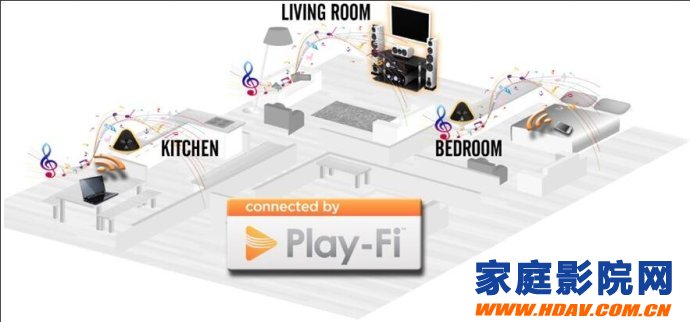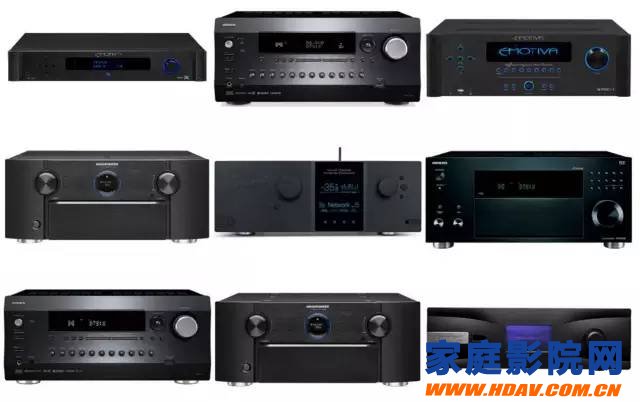[Home Theater Network HDAV.com.cn] Most home theater enthusiasts use the merger machine as the heart and brain of the entire system, but the merger is not the best solution because it must be a pre-processor (also known as the former Level) and the function of a multi-channel power amplifier combine to form a unit. For example, a power amplifier can heat up, which can degrade the degradation of precision electronics in the processor. (Class D amplifiers are now widely used in mergers, and they are effective in mitigating heat compared to previous designs.)
In order to reduce costs, the audio quality of the combined machine is usually worse than using a dedicated preamp and using one or more separate amplifiers - which means that the cost of the preamplifier system will be higher than that of the merger. of course. It is also possible to upgrade the predecessor without replacing the amplifier.
There are many factors to consider when purchasing a predecessor. Here are some considerations:

1, input and output
- Most modern preamps have HDMI 2.0 input and HDCP2.2 copy protection technology to support 4K/UHD content transmission.
- HDR10 technology, support for ultra-clear Blu-ray playback and compatibility with online streaming media playback, also requires a HDMI 2.0a and HDCP2.2 standard preamp.
- Determine if the transmission speed of the HDMI port is 10.2Gbps or 18 Gbps, and 18 Gbps is better.
- If you plan to connect or disconnect the source device (such as a game console or camera) regularly, the HDMI input on the front panel is a plus sign.
- Some preamps offer two HDMI outputs, one of which can be used to connect a projector or flat panel TV in the main room; another HDMI output is sent to the TV in another room, but this may require a fiber or the same Axis HDMI cable.
- A few pre-levels will provide HD BaseT connectivity. (HDBaseT: An audio and video interface standard, based on network transmission, which can combine audio, video, network, control signals and power supply lines. It is transmitted as a transmission cable using a common network cable.)
- Some preamps offer non-synchronous USB DACs that can be played directly from high-resolution audio source devices, which is critical for enthusiasts.
- If your source device relies on fiber optic or coaxial digital connections, make sure that the front device you choose has enough input to meet your needs.

2, the number of channels
- The 5-channel preamp is the most basic and usually the most affordable.
- 7-channel preamps can usually handle Dolby Atmos and DTS:X in 5.1.2 configurations as well as in traditional 7.1 systems.
- The 9-channel preamp usually achieves 5.1.4 panoramic sound and DTS:X, giving the listener an immersive experience.
- The 11-channel preamp can support 7.1.4 panoramic sound or DTS: X.

3, immersive audio
- Support for immersive audio is now very popular.
- The most common immersive audio format is Dolby Atmos; most immersive audio uses this format.
- There are now more and more predecessors supporting DTS:X, but there is not a lot of content encoded in this format.
- Some predecessors will also support Auro 3D, but this is usually an unnecessary expense. Because there is not much content currently encoded by Auro 3D.
- It is recommended that you purchase a front stage of at least 9 channels, which can reproduce 5.1.4 immersive audio. Of course, 5.1.2 is not bad, but the 5.1.4 and 7.1.4 systems can better convey the sound movement and render the atmosphere.

4, room sound field correction
- Room sound field correction - this is mainly to compensate for the acoustic irregularities in the room - this is also a point we must carefully consider when purchasing the predecessors of different brands.
- There are companies such as Hymn, Onkyo and Yamaha that use their own proprietary systems; others, such as Marantz, use more sophisticated third-party solutions such as Audyssey and Dirac Live.
- Different "room sound field correction" systems have great differences in performance.
- Audyssey MultEQ XT32, Dirac Live and Chorus ARC are acclaimed room sound field correction systems.
- Some "special sound and room combinations" have a better "room sound field correction" effect.

5, network connection
- The pre-levels produced in 2016 will basically support network connections.
- If you don't want to use a wireless router to locate the preamp, or use a home automation IP, the Ethernet port is very efficient. In addition, wired Ethernet connections ensure that audio transmitted from other devices is lossless.
- Many pre-levels use Wi-Fi to be compatible with AppleAirPlay, DTS Play-Fi and other wireless AV systems.
- Another more effective feature is to play directly from a DLNA server connected to the home network.

6, multi-room wireless function
- Many preamps offer multi-room or multi-zone operation where separate source signals can be sent to other rooms in the home via HDMI and audio signal lines. This feature has been implemented many years ago and usually consists of two or three separate areas (the main room is included).
- Recently, "Wireless Family Audio Features" has appeared. Some brands only offer their own proprietary systems, such as Denon HEOS, Yamaha MusicCast, which can only be used with other products from the same manufacturer; other brands, such as Onkyo, use third-party platforms such as Apple AirPlay, Google Cast and DTS Play-Fi.
- If you plan to use Bluetooth, it is best to look for an aptX technology that guarantees high quality audio transmission.
- Many pre-levels support streaming audio from the cloud.
7, analog input
- Unless you have a Legacy video source (such as a LaserDisc player or VCR), analog video input (such as component or composite video) is completely unnecessary.
- If you have an analog audio source, first make sure that the preamp you are planning to purchase has enough analog audio input to accommodate the audio source.
- If you want to enjoy vinyl records, you must purchase a preamp that provides the input of the player.

8, remote control and application-based control
- Since the front stage is a complicated device, they usually come with a button remote control.
- In the past, many predecessors had an RS-232 serial port for connecting home automation systems from companies such as Crestron, but this has now been replaced by home network IP controls.
- Many pre-level manufacturers also offer control apps for use on mobile phones and tablets, but their functionality varies widely. If you prefer to use mobile devices for control, you must consider the performance of your application.
- If you plan to use an infrared remote control and plan to put the front panel in the cabinet or closet, then you should have an IR input machine.

9. Budget and recommendations
- In the recommendations we give here, the price of the product is basically the manufacturer's suggested retail price, not the price on the market; in many cases, you can buy these products at a lower price.
- If you want to buy a machine that supports immersive audio, the budget for the predecessor must be no less than $2,000.
- Loman Voice Emotiva MC-700 ($599): 7.1-channel, 4K/HDR support, Emo-Q room sound field correction, Bluetooth 3.0, aptX technology support;
- Loman Voice Emotiva XMC-1 ($1999): 7.2 channels, 4K support, DiracLive room sound field correction system, decoding Atmos and DTS: X, 7.2.4 channels, 2 zones, support USB audio;
- IntegraDHC-60.7 ($2,000): 7.2-channel processing, 4K/HDR support, AccuEQ room sound field correction system, support for Atmos, DTS: X, AirPlay, DLNA, online audio playback, 2 zones, HDBaseT Features;
- Marantz Marantz AV7703 ($2,199): 11.2 channels, 4K / HDR support, AudysseyMultEQ XT32 room sound field correction system, support for Atmos, DTS: X, Auro 3D upgrade, support for AirPlay, Wi-Fi, Bluetooth, support HEOS family wireless audio, 3 areas;
- Onkyo PR-RZ5100 ($2,399): 11.2 channels, 4K / HDR support, AccuEQ room correction system, Atmos, DTS: X, AirPlay, Google Cast, Bluetooth, Wi-Fi, transportable Online audio streaming with FireConnect technology for multi-room wireless audio playback (3 zones);
- Integra DRC-R1 ($2,500): 11.2 channels, 4K/HDR support, AccuEQ room correction, Atmos, DTS: X, AirPlay, Google Cast (future update) wireless transmission, online audio streaming, USB, FireConnect multi-room wireless audio playback (future update) with HDBaseT interface;
- Yamaha CX-A5100 ($2,500): 11.2 channels, 4K/HDR support, YPAO room sound field correction, Atmos, DTS: X, online audio playback, support for MusicCast multi-room wireless intelligent system, built-in Wi- Fi, support Bluetooth, AirPlay;
- Hyde Anthem AVM60 ($3,000): 11.2 channels, 4K/HDR support, ARC space acoustic correction system, Atmos, DTS: X support; online audio playback, Play-Fi multi-room wireless audio, 2 area;
- Marantz Marantz AV8802A ($3,999): 11.2 channels, 4K/HDR support, AudysseyMultEQ XT32 room sound field correction system, support for Atmos, DTS: X (upgrade), Auro 3D (upgrade), support for AirPlay, Wi- Fi, Bluetooth, DLNA, can play online audio;
- Voice of the Earth Datasat LS10 ($11,000): 15 channels, support for some 4K (HDMI upgrade can fully support 4K / HDR), with Dirac Live space correction system, support for Atmos, DTS: X (upgrade), Auro 3D (optional), supports USB audio, and can be controlled by IP and RS-.
- Voice of the Earth DatasatRS20i ($23,000): 16 channels, support for some 4K (improved full 4K/HDR, HDMI upgrade), with DiracLive space correction system, support for Atmos, DTS: X (upgrade), Auro 3D ( Optional), support USB audio, can be controlled by IP and RS-232;
- Trinnov Altitude32 (prices up to $31,500, depending on configuration): 32-channel independent processing, support for some 4K (HDMI 2.0, hardware upgrade support), support for Atmos, DTS: X, Auro 3D; Loads the Trinnov Optimization Acoustic Correction System with Wi-Fi and an additional $650 for a 3D calibrated microphone.
More fresh and fun home theater information, please pay attention to home theater network http:// (WeChat: cnhifi), the country's most influential home theater audio player interactive media website.
Product Advantages
♦ Best optical transparency
♦ Versatile activation,Maintenance free, scratch-proof
♦ Durable, maintenance free with long-life expectancy
♦ Multi-touch 20 points detection,Plug and play
♦ Easy installation,Low power consumption, powered through USB
Ir Touch Frame,Ir Touch Screen Kit,Install Infrared Touch Panel,Ir Touch Frame Diy
ShenZhen GreenTouch Technology Co.,Ltd , https://www.bbstouch.com